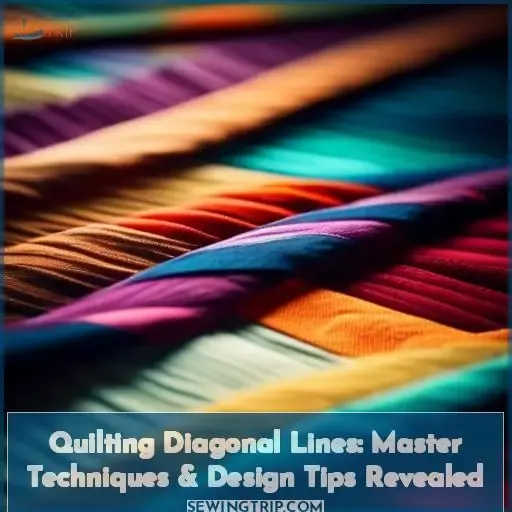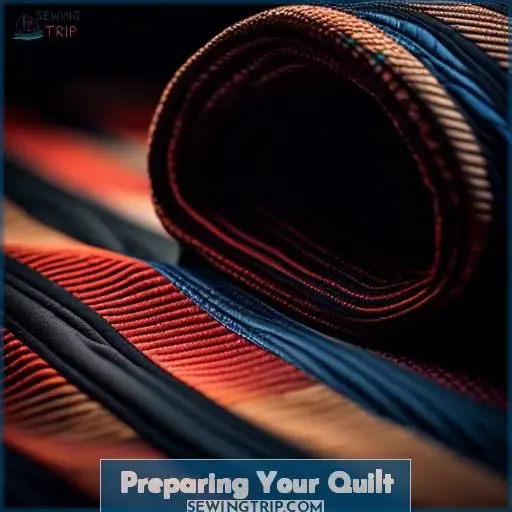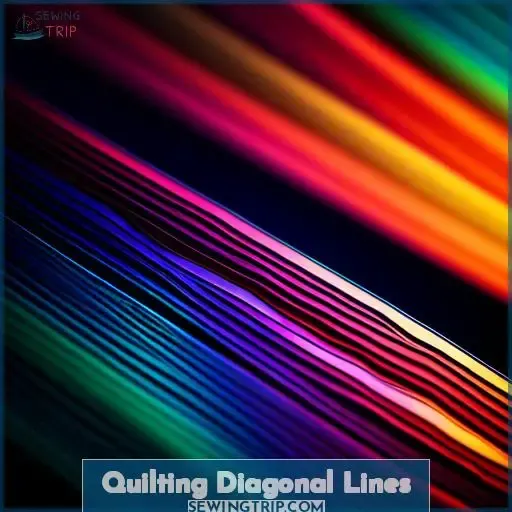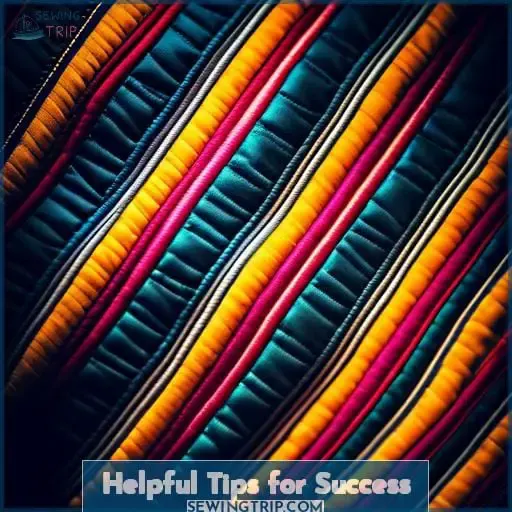This site is supported by our readers. We may earn a commission, at no cost to you, if you purchase through links.
 Discover the precision of quilting diagonal lines, a technique that elevates the artistry of your quilts.
Discover the precision of quilting diagonal lines, a technique that elevates the artistry of your quilts.
You’ll learn how to mark, stitch, and finish with confidence, transforming your quilt tops into masterpieces.
This guide reveals essential tips and advanced methods, from using a walking foot to exploring grid quilting, ensuring your lines are sharp and your designs impactful.
Embrace the challenge and innovation of diagonal quilting to create works that resonate with skill and creativity.
Table Of Contents
Key Takeaways
- Utilize painter’s tape and a ruler to mark diagonal lines on the quilt, ensuring they align with the quilt’s natural grid for a harmonious design.
- Employ a walking foot or guide bar on the sewing machine to maintain even stitches and fabric tension, reducing puckering and ensuring smooth lines.
- Experiment with different stitching techniques, such as starting at the quilt’s center or corner, rotating the quilt after each line, and trying zigzag stitches or grid crosshatching for added texture and depth.
- Consider design variations by adjusting the spacing of the diagonal lines, using uniform, variable, echo, or random spacing, and employing advanced techniques like echo quilting and free motion quilting for unique effects.
How to Quilt Diagonal Lines
To quilt diagonal lines, mark your quilt top with diagonal lines using a ruler and a marking tool, then stitch along these lines with a walking foot to ensure even fabric feeding. This technique adds a modern or classic design element to your quilt, depending on the angles and spacing chosen.
Preparing Your Quilt
Before you start quilting diagonal lines, you’ll need to gather your materials and properly mark your quilt.
Setting up your machine correctly is crucial for achieving straight, even stitches.
Materials Needed
Ready to tackle diagonal quilting? You’ll need:
- Basted quilt sandwich
- Painter’s tape for precision
- Trusty walking foot or guide bar
- Quilting thread that pops
Gear up, it’s quilting time with style and accuracy!
Marking Diagonal Lines
After gathering your materials, it’s time to dive into marking diagonal lines. Grab your painter’s tape and ruler; these are your best pals for precision.
Lay the tape across your quilt, envisioning your future stitches. This step transforms your quilt from a blank canvas into a roadmap for your machine quilting adventure.
Whether you’re using a walking foot or embracing the freedom of free motion, these marked lines guide your journey, ensuring every stitch contributes to the masterpiece.
Setting Up Your Machine
Before diving into straight line quilting, attach your walking foot to your home machine, ensuring smooth fabric feed.
Install the guide bar to ace diagonal crosshatching, and load your quilt diagonally to prevent fabric tugging.
Quilting Diagonal Lines
When quilting diagonal lines, begin by determining your starting point; either from the middle working outwards or from one corner across to the opposite.
Rotate your quilt after each line to maintain even tension and avoid distortion, ensuring a professional finish.
Starting Points and Quilt Rotation
When quilting diagonal lines, your starting points and quilt rotation are crucial for a crisp finish.
- Begin at the quilt’s heart, radiating outwards.
- Rotate after each line to dodge distortion.
- For lone star or mariners compass patterns, align with the natural grid.
- Grouped spacing adds pizzazz; free-motion quilting offers freedom.
Stitching Techniques
When quilting diagonal lines, thread tension and stitch length are key. Harriet Hargrave’s Heirloom Machine Quilting suggests straight lines for a classic look.
| Thread Tension | Stitch Length |
|---|---|
| Balanced | 2.5 – 3.0 |
| Adjusted | Custom |
Finishing Touches
Once you’ve mastered the diagonal machine stitch, consider experimenting with grid crosshatching or free motion line work.
Zigzag stitch variation adds texture.
Design Considerations
When planning your quilt’s diagonal lines, consider the quilt’s natural grid and the direction of your lines. Your choice in spacing can significantly impact the quilt’s overall appearance and texture.
The quilt’s natural grid refers to the underlying structure of the fabric, which is typically a grid of woven threads. The direction of the diagonal lines can be influenced by the orientation of this grid.
Spacing the diagonal lines closer together can create a more textured, intricate appearance, while spacing them farther apart can result in a more open, airy design.
Additionally, the angle of the diagonal lines can also affect the overall look of the quilt. Steeper angles can create a more dynamic, angular appearance, while shallower angles can result in a more subtle, flowing design.
Natural Grid and Direction
As you transition from quilting basics to mastering diagonal placement, remember, your quilt’s natural grid guides you.
- Align diagonal lines with the quilt’s blocks for seamless parallel lines.
- Use vertical stripes as markers for intersection points.
- Experiment with angles to add depth and intrigue, keeping lines crisp and intersections neat.
Spacing Options
After exploring the natural grid and direction, let’s dive into the crucial aspect of spacing options. Your quilt’s appeal hinges on mastering spacing techniques, a cornerstone of quilt design.
| Spacing Type | Considerations |
|---|---|
| Uniform | Simplicity and harmony |
| Variable | Dynamic and engaging |
| Echo | Depth and texture |
| Random | Whimsical and unique |
Embrace these options to elevate your quilting game!
Helpful Tips for Success
To ensure your diagonal quilting lines are even and precise, consider using a walking foot; it helps maintain consistent stitching. For added texture and visual interest, try stabilizing stitching or incorporating echo lines and variable spacing.
Using a Walking Foot
Transitioning from design to execution, you’ll find the walking foot indispensable.
- Adjust foot tension for smooth stitches.
- Check foot pressure to prevent fabric puckering.
- Regular foot maintenance ensures longevity.
- Explore foot accessories and replacement options.
Stabilizing Stitching
Dive into quilting with a game plan: stabilizing methods are your secret weapon.
Think of your design grid as a roadmap, where stitch direction, echo lines, and variable spacing are key players.
It’s like quilting GPS!
Echo Lines and Variable Spacing
After stabilizing your quilt, it’s time to jazz things up with echo lines and variable spacing.
- Experiment with different echo widths
- Play with spacing to create rhythm
- Introduce contrast with varied line densities
Advanced Techniques
To elevate your quilting, explore diagonal loading and zigzag stitching.
Utilize rulers and marking tools for precise diagonal lines and creative design options.
Consider the grid method for accurate placement and alignment of quilt blocks.
Experiment with free motion quilting to add unique textures and patterns to your quilts.
Diagonal Loading and Zigzag Stitching
When quilting diagonal lines, consider zigzag angles and echo quilting for dynamic effects. Use custom templates to maintain consistency and variable density for visual interest.
| Technique | Benefit |
|---|---|
| Zigzag Angles | Adds dynamic texture |
| Echo Quilting | Creates depth |
| Custom Templates | Ensures uniformity |
Grid Method and Free Motion Quilting
- Choose your grid selection wisely; it sets the stage.
- Swap to a free motion foot for artistic freedom.
- Play with variable spacing and echo quilting for depth.
Rulers and Marking Tools
Dive into quilting with rulers and marking tools, your allies for perfect diagonal crosshatching.
Laser pointers and chalk lines guide your stitches with precision.
It’s like having a roadmap for your quilt’s journey—no detours, just beautiful results.
Frequently Asked Questions (FAQs)
Can I quilt diagonal lines without a walking foot?
Sure, you can quilt diagonal lines without a walking foot; just use a standard presser foot and guide bar for spacing.
How do I choose the best thread for quilting?
Choosing the best thread for quilting is like finding the perfect spice for a dish; it elevates your project.
Opt for long staple cotton for its low lint and strong, yet fine, qualities, ensuring seamless stitches.
What are common mistakes when quilting diagonal lines?
Common quilting blunders include not starting in the middle, causing puckering, and uneven spacing.
Ensure you’re basting well, using painter’s tape for guidance, and keeping a steady pace to dodge these pitfalls and ace your diagonal lines.
How do I fix puckering in diagonal quilting?
Like a ship navigating choppy waters, fixing puckering in diagonal quilting requires a steady hand and precise adjustments.
Ensure even fabric tension, use a walking foot, and practice on a sample to master the technique.
Can diagonal quilting be done on any quilt size?
Yes, diagonal quilting can jazz up any quilt size, from tiny baby blankets to massive king-sized covers.
It’s all about getting those lines straight and avoiding the dreaded fabric bunch-up.
Conclusion
Just as a navigator uses stars to chart a course, you’ve learned to guide your quilting journey with precision. Mastering how to quilt diagonal lines is a key skill in your toolkit. Your toolkit now includes everything from marking to stitching, and from basic techniques to advanced strategies.
With your walking foot as your compass and a variety of marking tools at your disposal, you’re set to transform quilt tops into stunning masterpieces. Embrace this knowledge, and let your creativity and skill shine through every stitch.










